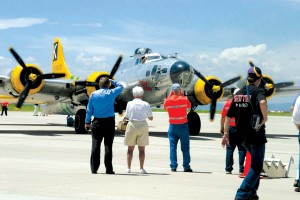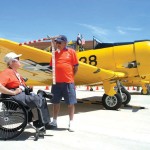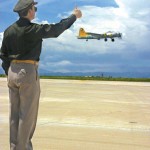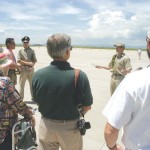By Bill Stansbeary
On Sept. 2, 2005, it will be 60 years since the end of World War II. The Experimental Aircraft Association is commemorating the end of that conflict as well as honoring those who sacrificed during that time. EAA’s salute to the men, women and aircraft of that time includes a national “Allied Victory Tour” by one of the greatest military airplanes ever built, a B-17 “Flying Fortress” bomber.
With stops in the western United States to highlight the flight schedule for the spring and early summer portion of the 2005 tour, the B-17 will continue flying through this fall. EAA pilots will fly the B-17 “Fuddy Duddy,” which is based at the Wings of Eagles Discovery Center in Elmira, N.Y.
The first leg of the B-17 includes 28 stops in 10 states. The airplane will also be part of a WWII heavy bomber reunion at EAA AirVenture in Oshkosh, Wis. The B-17 tours have taken place each spring and fall since 1994. Since EAA began the tours, tens of thousands of people have experienced this unique airplane through its visits and aircraft ground tours. Thousands of aviation enthusiasts have actually flown in the renowned bomber, which is one of the best-known aircraft types of the WWII era.
“Fuddy Duddy” was designed by the Boeing Company, in Seattle, and built under license by the Douglas Aircraft Company in 1944, at their plant in Long Beach, Calif. It was then delivered to the U.S. Army Air Corps, Pacific Theater. Converted for use as a VIP transport, General Dwight D. Eisenhower used the aircraft on his tour of the South Pacific in 1946. General Douglas MacArthur also used the VIP airplane in the 1950s.
The airplane’s paint scheme now matches that of the original “Fuddy Duddy,” a B-17G which was assigned to the 8th Air Force’s 447th Bomb Group, 708 Bomb Squadron, during WWII.
At each stop, flight “missions” are available in the airplane, which allow people to take flights in this spectacular aircraft. Through the past decade of national tours, EAA’s B-17 has created many emotional reunions for veterans who participated in B-17 operations during WWII. For most, it was their first “mission” in a Flying Fortress since that era. Even though more than five decades have passed since their wartime experience, the outpouring of emotion and memories have created a unique link through these veterans. They have often shared their stories, while also recalling and honoring their long-ago comrades, during the B-17’s visits to their communities.
The required 10 crewmembers of the B-17 included the pilot, copilot, navigator, bombardier, flight engineer (top turret gunner), radio operator, two waist gunners, tail gunner and ball turret gunner. Of the total production of 12,732 built, there are only about a dozen B-17s still flying today.
For more information regarding these flights, including ground tour and flight rates, visit www.b17.org or contact EAA’s B-17 Tour Office at 800-359-6217. Special rates on flights are available for EAA members, and group rates are available for ground tours by schools or other large groups. The airplane’s crew is available at each stop to answer questions.
- L to R: Norm Avery and David Fain, Wings Over the Rockies volunteers, reminisce while on “watch.”
- J. Clark Hearn gives the “Fuddy Duddy” a thumbs up.
- The B-17 crew briefs the next group who will take a ride on the “Fuddy Duddy.”
















